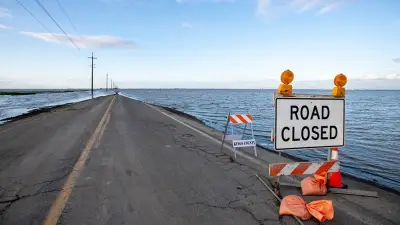Floods exposed weaknesses in California prisons’ emergency plans — but they still aren’t ready

FILE Growing Tulare Lake cuts off th Avenue south of Corcoran in Kings County Courtesy DWR In amid record-breaking rain and snow two prisons in the southern San Joaquin Valley faced a serious danger of flooding But neither prison California State Prison Corcoran or the Substance Abuse Medication Facility had a robust evacuation plan on hand and ready for the looming catastrophe Instead the prisons developed a joint plan to transfer roughly incarcerated people to other state prisons within to days or longer Wheelchair-bound individuals the plan stated would take six days to evacuate And department buses intended to shuttle people to safety could take up to a day to arrive The floods that year ultimately did not reach the prisons but the threat they posed illustrated how California s -prisoner corrections system has failed to prepare for natural disasters That s according to a account issued this month by an independent agency that oversees the department s disciplinary process and internal investigations While California s prisons are vulnerable to wildfires floods and earthquakes we revealed they are not adequately prepared to respond to emergencies posed by natural disasters stated the statement by the Office of Inspector General which reviewed crisis plans for state prisons after fielding concerns about the department s calamity response The description detailed deep fractures in the department s crisis preparedness including issues of transportation varied exposure assessment methodologies lacking mutual aid agreements timely evacuations and prison overcrowding As of December California s prison system was operating at roughly or people over its designed maximum according to the review Not only are particular prisons overcrowded but the department is unable to evacuate the incarcerated population and staff at preponderance prisons within the first critical hours of an crisis the record noted Without the ability to rapidly evacuate prisons it is likely that wildfires floods and earthquakes will product in loss of life within the incarcerated population Notably the inspector general determined that none of the prisons included a plan to evacuate incarcerated people outside their gates but rather focused on moving the incarcerated population to and from locations within the prison The assessment concluded with a list of recommendations including ones that would bring the California Department of Corrections and Rehabilitation into compliance with California regulations around crisis planning Carlee Purdum an assistant professor of sociology at the University of Houston who researches how disasters impact incarcerated people mentioned the assessment is a first step in identifying more tools to backing prisons and corrections agencies as they plan and prepare I ve never seen anything like this before Purdum noted Prisons and corrections agencies are very marginalized and isolated in the crisis and calamity planning space The major takeaway should be that we have not engaged in these kinds of discussions and put forth the kind of state level tools and accountability into these institutions Advocates for years have been sounding the alarm over the solutions in which California prisons are ill-equipped to confront weather hazards due to issues such as overcrowding and aging infrastructure A assessment by the UCLA Luskin School of Citizens Affairs and the nonprofit organization Ella Baker Center for Human Rights chronicled those concerns and urged the state to implement safeguards People inside have a fear that the actual plan is to abandon them in the occurrence of an exigency It is deeply troubling revealed James King director of programs for the Ella Baker Center for Human Rights In these constituents wellbeing crises it s not just going to affect the people in the prisons either incarcerated there or working there It s going to impact the entire county the entire locality Trucks driving through the flooded intersection on Highway near Corcoran on March The flood was caused by rising water levels on the Tule River after a series of storms Photo by Larry Valenzuela CalMatters CatchLight Local Those concerns were echoed by Dax Proctor statewide coordinator for Californians United for a Responsible Budget a statewide coalition of organizations that view atmosphere hazards as a key reason to close prisons The number one explanation to address these issues at hand is to reduce the number of people locked up in California prisons as rapidly as manageable Proctor announced A good starting place would be those most of vulnerable to conditions hazards Personnel from the California Department of Corrections and Rehabilitation and the California Governor s Office of Urgency Services answered questions about the summary before lawmakers at a hearing Thursday They assured lawmakers that the department would not work alone in a large-scale emergency California has a vast amount of tools and we would rely heavily on our federal state and local partners to assist us with the evacuation of an entire prison mentioned Melissa Prill special agent-in-charge at the corrections department s Office of Correctional Safety But Sen Laura Richardson a Democrat from Inglewood noted that in an unpredictable situation those partners may be busy assisting other people To assume that these other agencies are going to be available to help you or to help us in a prison ecosystem is not something going forward we have the freedom to assume Richardson declared I would give this office of inspector general s assessment of your organization I would consider it an F frankly Sen Kelly Seyarto a Republican from Murrieta stated he wasn t extremely critically concerned I think we re getting a little overboard in terms of thinking that we are going to have to evacuate entire prisons Seyarto commented It s just not a practical thing to think that somehow the whole prison is going to catch on fire In a announcement to CalMatters department spokesperson Mary Xjimenez explained prisons take an all-hazards approach to urgency planning and that it coordinates its plans with the Governor s Office of Exigency Services The department follows the FEMA National Situation Management System which is the national doctrine that provides all federal state and local response agencies with a consistent set of principles management structures and a systematic approach to emergency response King declared the department has a history of being unprepared for context hazards and instead reacts to them once they inevitably occur These are totally facts King commented The department could accept these facts and do something about them or they could try to manage their response to the analysis Disappointedly it seems like they ve chosen the latter This is an opportunity to improve their response to see the gaps and to create plans that address the gaps Cayla Mihalovich is a California Local News fellow CalMatters is a populace interest journalism venture committed to explaining how California s state Capitol works and why it matters


